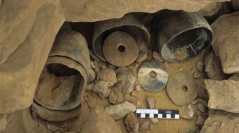

 Comptes Rendus Palevol
5 (1-2) - Pages 409-419
Comptes Rendus Palevol
5 (1-2) - Pages 409-419The eastern Sahara of Egypt, Sudan and Libya – also called the 'Libyan Desert'– constitutes the most arid part of the entire Sahara, with almost no rainfall and thus a lack of any human occupation. For this reason, and because the climate regime is not influenced by higher topographic features, this region provides a unique study area for the relationship between changing climates and human occupation, using Man as a sensitive indicator of past living conditions. In a synoptic view based on some 500 radiocarbon dates, the Holocene human occupation of the eastern Sahara is presented here in four major time slices.
Libyan Desert, Early and Mid-Holocene, climate change, human occupation, radiometric data, archaeology